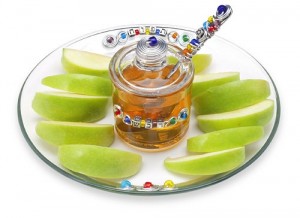Anyone who observes Rosh Hashanah knows that this is one holiday when you might as well forget about counting calories, reducing carbs, or sticking to a weight-loss plan. In Jewish households, the tables sag beneath the weight of tempting delicacies, comfort foods, and traditional desserts. When faced with this kind of temptation, it’s best to give in, indulge for two days and pray for the willpower to go back to your diet on the third.

What I find interesting is the symbolism in the foods that Jews eat for Rosh Hashanah. Since it’s considered the Jewish New Year, we eat a lot of honey as a way to say we’re hoping for a sweet new year. A popular tradition is to eat honey on apples, a reminder of the creation story.
Honey also becomes a dip for challah, sweetened for the occasion with raisins or more honey-baked right into the bread. During this holiday, the loaf is round to symbolize the circle of life.
Then there are the honey cakes. Every family has a favorite recipe that’s likely to have been passed down from generation to generation. Flavored with fragrant spices like cinnamon, cloves, and allspice, these are the ultimate fall treat that smells heavenly while baking. My new favorite honey cake is this one that’s moist and rich – and topped with a chocolate glaze.
A healthy traditional Rosh Hashanah food is a new fruit that’s just come into season. When we eat this fruit, we say the shehecheyanu blessing to thank God for keeping us alive and well for the beginning of a new year.
The pomegranate, which Jewish lore tells of 613 seeds, being the same number of mitzvoth or commandments in the Torah. The seeds serve as a reminder that our good deeds in the coming year should be as plentiful as the number of tart seeds in the pomegranate.
Another Rosh Hashanah staple is carrots sliced into coins to represent prosperity. The carrots are, used in soups and stews made slightly sweeter than usual for this holiday.
And finally, although it’s customary in some Jewish traditions to serve fish head to symbolize Rosh Hashanah as the “head” of the year, I’m not there yet.
And I’d prefer to save my calories and indulge in something sweet and wonderful like this noodle kugel made from my mother-in-law’s recipe. It’s everyone’s favorite, so I hope you’ll try it!
Louise’s Noodle Kugel
1 12-oz. bag of “no-yolk” noodles
1 16-oz. container cottage cheese
1 16-oz. container sour cream
2-eggs, beaten
8-packages Sweet N Low
1 tsp. cinnamon
½ cup raisins
1-stick margarine
1-small jar peach or apricot preserves
Preheat oven to 375°. Boil noodles until soft. Melt margarine in an 8 ½” x 11” baking pan in the oven. In a large bowl: mix the noodles with the cottage cheese, sour cream, eggs, Sweet N Low, cinnamon, and raisins. Spread evenly in the pan and bake covered for 1 hour. Remove from the oven and spread the jar of preserves over the top. Return to the oven uncovered for 15-20 minutes.
What’s your favorite Rosh Hashanah dish or recipe?

